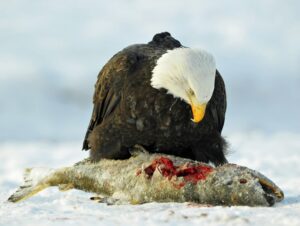Does Eagle Eat Dead Animals or No?

naturepreservehub.com. Does Eagle Eat Dead Animals or No? – Discover the fascinating feeding habits of eagles in this comprehensive article. Learn whether eagles eat dead animals, their dietary preferences, and more. Gain insights into the natural behavior of these majestic birds of prey.
Eagles, the majestic birds of prey known for their impressive hunting skills and keen eyesight, have long captivated our imagination. A common question that arises is, “Does Eagle Eat Dead Animals or No?” To uncover the truth behind this query and explore the dietary habits of eagles, we delve into their feeding preferences, behaviors, and adaptations.
In this article, we’ll address key questions, dispel myths, and shed light on the remarkable world of these apex predators.
Does Eagle Eat Dead Animals or No?
Yes, eagles do eat dead animals. While eagles are primarily carnivorous and prefer to hunt live prey, they are opportunistic feeders and will consume carrion (dead animals) if they come across it.
Carrion provides an easy source of food for eagles, especially when live prey is scarce or unavailable. Eagles have powerful beaks and talons that allow them to tear into and feed on carcasses. This behavior is not uncommon among many bird species, including scavengers like vultures and certain types of eagles.
One of the most frequently asked questions about eagles is whether they consume dead animals. Contrary to popular belief, eagles do exhibit scavenging behavior, meaning they occasionally feed on carrion—dead animals.
However, this behavior varies among different eagle species and is not a primary source of their diet. Eagles are predominantly skilled hunters, relying on their impressive talons and sharp beaks to catch live prey.

The Varied Diet of Eagles
Eagles are opportunistic predators with diverse diets that largely depend on their species, habitat, and local food availability. While their primary diet consists of live prey, which includes various mammals, birds, and even fish, eagles are known to scavenge when the opportunity arises. Some of the typical items found in an eagle’s diet include:
- Small mammals: Rabbits, squirrels, rodents
- Birds: Ducks, herons, seagulls
- Fish: Eagles are skilled fishermen, swooping down to catch fish from bodies of water
- Reptiles: Snakes, lizards, and occasionally, turtles
- Carrion: Eagles may consume dead animals, particularly when live prey is scarce
The Diet of Bald Eagle
The diet of the Bald Eagle primarily consists of fish, as they are highly skilled at hunting and catching aquatic prey. Fish make up a significant portion of their diet, and they will often swoop down to the water’s surface to snatch fish using their sharp talons. Bald Eagles are known for their incredible eyesight, which allows them to spot fish from great heights.
However, Bald Eagles are opportunistic predators and their diet isn’t limited to fish alone. They are known to feed on a variety of other animals as well, including waterfowl, small mammals, carrion (dead animals), and even birds. They may scavenge for food or steal prey from other birds and animals.
In areas where fish are less abundant, Bald Eagles adapt by incorporating more diverse food sources into their diet. Their adaptable eating habits contribute to their success in a wide range of habitats across North America, from coastal regions to inland areas near lakes and rivers.
The Diet of Golden Eagle
The Golden Eagle has a diverse and varied diet that includes a wide range of prey. Their diet is primarily carnivorous, and they are skilled hunters with a keen sense of sight that allows them to locate prey from great distances. Here are some of the main components of the Golden Eagle’s diet:
- Small Mammals: Golden Eagles often hunt small mammals such as rabbits, squirrels, and marmots. They use their powerful talons to capture and kill these prey items.
- Birds: Birds, ranging from small passerines to larger waterfowl, can also be a part of the Golden Eagle’s diet. They may hunt birds in flight or catch them on the ground.
- Reptiles: In some regions, Golden Eagles might feed on reptiles such as snakes and lizards.
- Carrion: Like other eagles, Golden Eagles are opportunistic feeders and will scavenge for carrion when they come across it. They may feed on the remains of animals that have already died.
- Hares and Rabbits: Larger prey like hares and rabbits are also targeted by Golden Eagles, especially in open and grassland habitats.
- Ground Squirrels: In certain areas, ground squirrels are an important part of the Golden Eagle’s diet.
- Fish: While not as common as in the diet of Bald Eagles, Golden Eagles near water bodies might occasionally catch fish.
- Other Small Animals: Depending on the region and availability of prey, Golden Eagles might also feed on insects, smaller mammals like mice, and even the young of larger mammals.
Golden Eagles are adaptable predators that adjust their diet based on the available prey in their habitat. Their hunting techniques involve soaring at great heights to spot potential prey and then using their swift flight and powerful talons to catch and kill their target.
The Diet of African-Fish Eagle
The African Fish Eagle, as its name suggests, has a diet that predominantly revolves around aquatic prey, especially fish. Found near bodies of water such as rivers, lakes, and coastal areas across sub-Saharan Africa, the African Fish Eagle has evolved to be a specialized hunter of aquatic creatures. Here’s an overview of its diet:
- Fish: Fish make up the majority of the African Fish Eagle’s diet. They are skilled hunters and have developed techniques to catch fish from the water’s surface. The eagle will often perch in a high spot near the water and then dive down to snatch fish with its sharp talons. This hunting behavior is a hallmark of the African Fish Eagle’s feeding habits.
- Waterfowl: In addition to fish, the African Fish Eagle may also prey on waterfowl such as ducks, coots, and other birds that inhabit or frequent the same aquatic environments.
- Amphibians and Reptiles: While less common than fish and waterfowl, African Fish Eagles might also consume amphibians like frogs and certain reptiles that are found around water bodies.
- Carrion: Similar to other eagles, the African Fish Eagle may scavenge for carrion when the opportunity arises. Carrion can provide an additional food source when live prey is scarce.
- Small Mammals: On occasion, the African Fish Eagle may target small mammals such as rodents that are found near water sources.
The African Fish Eagle’s diet is closely linked to its habitat and its specialization in hunting near water. Its striking appearance and distinctive call make it an iconic and recognizable bird in its range.
The Diet of Long-Crested Eagle
The Long-Crested Eagle, also known as the Long-Crested Hawk-Eagle, is a bird of prey found in various parts of sub-Saharan Africa. Its diet primarily consists of small to medium-sized prey found within its habitat. Here’s an overview of the Long-Crested Eagle’s diet:
- Small Mammals: The Long-Crested Eagle preys on a variety of small mammals such as rodents (mice, rats, and shrews) and small ground-dwelling mammals like squirrels.
- Birds: While not as common as some other prey items, the Long-Crested Eagle may hunt small birds, especially when opportunities arise. It might target fledglings or smaller species of birds.
- Reptiles: Reptiles, including lizards and snakes, are also part of the Long-Crested Eagle’s diet. They may hunt these animals on the ground or in trees.
- Insects: Insects could be a supplementary food source for the Long-Crested Eagle, particularly during times when other prey might be scarce.
- Amphibians: Depending on the availability, the eagle might occasionally prey on amphibians such as frogs.
The Long-Crested Eagle is known for its distinct appearance, with a long, prominent crest of feathers on its head. Its hunting techniques often involve perching in trees or elevated positions and scanning the surrounding area for potential prey. Once it spots prey, it may swoop down to capture it using its sharp talons.
As with many raptors, the Long-Crested Eagle’s diet is influenced by the availability of prey in its habitat, and it exhibits adaptability in its feeding habits.
The Diet of Philippine Eagle
The Philippine Eagle, also known as the Monkey-eating Eagle, is a critically endangered bird of prey found only in the Philippines. As the largest eagle in the world in terms of length, the Philippine Eagle has a specialized diet that primarily consists of a few key prey species.
Here’s an overview of the Philippine Eagle’s diet:
- Monkeys and Flying Lemurs: The Philippine Eagle’s common name, “Monkey-eating Eagle,” reflects its known predation on monkeys such as macaques and flying lemurs (colugos). These mammals make up a significant portion of the eagle’s diet and are considered its primary prey.
- Tree Squirrels: Another important component of the Philippine Eagle’s diet is tree-dwelling squirrels. These agile mammals are a suitable prey size for the eagle and are often found in its forested habitat.
- Other Small Mammals: In addition to monkeys and squirrels, the Philippine Eagle may consume other small mammals like bats and rodents.
- Birds: While not as common as its main prey items, the eagle might occasionally prey on birds, particularly smaller species that are found in its forested environment.
- Reptiles: The eagle’s diet might include reptiles such as snakes and lizards, although they are less frequently observed as prey.
The Philippine Eagle is specialized to its habitat, which includes the dense forests of the Philippines. It is an apex predator in its ecosystem and occupies the top of the food chain.
Due to its relatively low reproduction rate and habitat loss, the species is critically endangered. Conservation efforts are crucial for its survival and the protection of its unique diet and habitat.
The Steppe Eagle
The Steppe Eagle is a large bird of prey that inhabits a wide range of open habitats, including grasslands, steppes, and savannas, across parts of Europe and Asia. Its diet is varied and adapted to the availability of prey in its environment.
Here’s an overview of the Steppe Eagle’s diet:
- Small Mammals: The Steppe Eagle’s diet often includes small mammals such as rodents (mice, voles, and ground squirrels). These animals are commonly found in grasslands and open areas, making them accessible prey for the eagle.
- Birds: Birds make up a significant part of the Steppe Eagle’s diet. It might prey on various types of birds, including game birds, waterfowl, and smaller birds found in its habitat.
- Reptiles: Reptiles like lizards and snakes can also be targeted by the Steppe Eagle, especially in areas where these creatures are abundant.
- Insects: Insects might supplement the Steppe Eagle’s diet, particularly during times when other prey is scarce. It could include large insects like grasshoppers.
- Carrion: As opportunistic feeders, Steppe Eagles are known to scavenge for carrion (dead animals). They may feed on the remains of animals that have died due to natural causes or have been killed by other predators.
- Amphibians: Depending on the region and prey availability, the eagle might also consume amphibians like frogs.
The Steppe Eagle’s diet reflects its adaptability to different environments and its ability to exploit a variety of prey sources. It’s known for its migratory behavior, covering large distances during its annual migrations in search of suitable feeding and breeding grounds.
FAQs About Eagle’s Diet
Q: Are eagles strict carnivores?
A: Yes, eagles are carnivores, primarily feeding on animals such as mammals, birds, and fish.
Q: Do all eagle species scavenge?
A: Scavenging behavior varies among eagle species. Some are more prone to scavenging than others.
Q: Can eagles eat larger prey?
A: Some eagle species can take down larger prey due to their strength and hunting skills.
Q: Are eagles affected by habitat loss?
A: Yes, habitat loss can impact eagles by reducing their access to suitable hunting and feeding grounds.
Q: How do eagles locate prey from a distance?
A: Eagles have exceptional eyesight, which allows them to spot prey from high altitudes.
Q: What role do eagles play in ecosystems?
A: Eagles are apex predators and help maintain the balance of their ecosystems by controlling prey populations.
Conclusion
In conclusion, the question “Does Eagle Eat Dead Animals or No?” has a nuanced answer. While eagles are primarily skilled hunters, they do engage in scavenging behavior when circumstances dictate.
Their ability to adapt their diet to changing conditions is a testament to their survival instincts. Understanding the diverse feeding habits of eagles enriches our appreciation for these remarkable birds and their vital role in maintaining the balance of nature.




